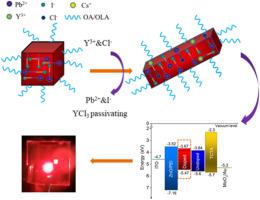Nano Energy ( IF 16.8 ) Pub Date : 2020-11-19 , DOI: 10.1016/j.nanoen.2020.105615 Gencai Pan , Xue Bai , Xinyu Shen , Lei Wang , Yanli Mao , Xu Chen , Wen Xu , He Shao , Donglei Zhou , Biao Dong , Lin Xu , Junhua Hu , Hongwei Song

|
One-dimensional (1D) CsPbI3 nanorods (NRs) possess the suitable bandgap, extinction coefficient, long exciton diffusion radius and directed conductive channel, which make them advantageous for numerous optoelectronic devices. However, the direct synthesis of high-quality CsPbI3 NRs remains a challenge. Here, we develop a direct and facile synthetic approach to prepare the CsPbI3 NRs by YCl3 promotion. The YCl3 is not only the inducement of anisotropic growth of NCs, but also the source of passivator for improving the stability of NCs. Because of an effective YCl3 passivation, the efficient red emitting CsPbI3 NCs with photoluminescence quantum yield (PLQY) of 97% was achieved. More importantly, the YCl3 promoted CsPbI3 NRs with small aspect ratio of ~3.2 exhibit the PLQY of 84%, the highest value obtained from the red perovskite NRs. The fluorescence anisotropy of 0.184 mmol-YCl3 promoted CsPbI3 NRs is 0.38, and the rotational diffusion time = 1000 ns. The analysis on fluorescence anisotropy of the CsPbI3 perovskite NRs proves that the size in length and width is consistent with the result measured by TEM images of as-prepared perovskite NRs. Meanwhile, conductivities of the films made of 0.184 mmol-YCl3 promoted CsPbI3 NRs is 2.94 × 10−1 S/cm, which is 17 times higher than 1.70 × 10−2 S/cm of bare CsPbI3 nanocubes. Furthermore, various CsPbI3 NCs are employed to prepare light-emitting diodes (LEDs). The YCl3 promoted CsPbI3 NRs based LEDs display an optimum external quantum yield (EQE) of 10.5%, and luminance of 1672 cd/m2. These results prove that the as-prepared YCl3 promoted CsPbI3 NRs have promising prospect in optoelectronic devices.
中文翻译:

鲜红色YCl 3促进的CsPbI 3钙钛矿纳米棒向高效发光二极管的转化
一维(1D)CsPbI 3纳米棒(NRs)具有合适的带隙,消光系数,长激子扩散半径和定向导电通道,这使其在众多光电设备中均具有优势。但是,直接合成高质量的CsPbI 3 NR仍然是一个挑战。在这里,我们开发了一种直接且简便的合成方法,可通过YCl 3促进来制备CsPbI 3 NR 。YCl 3不仅是诱导NCs各向异性生长的诱因,而且是提高NCs稳定性的钝化剂来源。由于有效的YCl 3钝化,有效的红色发光CsPbI 3实现了NC的光致发光量子产率(PLQY)为97%。更重要的是,YCl 3促进的CsPbI 3 NR长径比约为3.2,其PLQY为84%,这是从红色钙钛矿NR获得的最高值。0.184 mmol-YCl 3促进的CsPbI 3 NRs的荧光各向异性为0.38,旋转扩散时间 = 1000 ns。对CsPbI 3钙钛矿NRs荧光各向异性的分析表明,长和宽的大小与所制备钙钛矿NRs的TEM图像测量结果一致。同时,由0.184 mmol-YCl 3促进的CsPbI 3 NRs制成的薄膜的电导率为2.94×10 -1 S / cm,是裸露的CsPbI 3纳米立方体的1.70×10 -2 S / cm的17倍。此外,采用各种CsPbI 3 NC来制备发光二极管(LED)。YCl 3促进的基于CsPbI 3 NRs的LED的最佳外部量子产率(EQE)为10.5%,亮度为1672 cd / m 2。这些结果证明,制备的YCl 3促进的CsPbI 3 NRs在光电子器件中具有广阔的前景。































 京公网安备 11010802027423号
京公网安备 11010802027423号